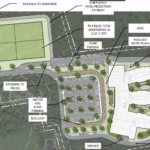During Monday night’s Zoning Advisory Committee meeting there was a public forum for zoning proposals and ideas. Not surprisingly, the conversation was focused on commercial solar zoning and how the town can better control the situation.
“This was not intended to be a solar meeting,” ZAC chair Mary Larson-Marlowe said with a smile, but that’s what residents wanted to discuss.
The Zoning Advisory Committee (ZAC) last year was tasked with designing and submitting a commercial solar zoning map for the Planning Board. After much discussion and debate, the map ended up highlighting parcels of land where solar already existed or had been permitted, along with a stretch of land along Interstate 495 and a piece at the E.L. Harvey facility on the Westborough line.
Due to the pandemic and the changes to Annual Town Meeting, the map did not go before voters. A new version is expected to be presented at next year’s Town Meeting.
Jane Moran, who is a member of the Planning Board, joined the public forum to reiterate her desire to focus more on coming up with a list of restrictions and less on identifying parcels on a map — especially if there’s no explanation with it.
The solar map “does not have verbiage or any documentation to back it up,” she said, adding that it could lead to trouble if the town has to defend it.
“We had heard from the assistant town counsel at a Planning Board meeting that stated that the state attorney general wouldn’t really look at the map, they would only really look at the verbiage that came out of the Planning Board, via the ZAC — in this case the verbiage is going to come out of the ZAC,” she said.
At a previous ZAC meeting Moran had suggested adding specifics to the wording of the bylaw, including restricting the percentage of the lot that can be used for solar as well as grade restrictions.
“Strengthen up the bylaw and be very specific about what can and can’t go into a commercial zoning bylaw,” she said.
Added Moran: “I think it’s going to take some work to come up with some congenial language that would meet all of the needs of not only the private property owners and the abutting neighbors but also the town, and what our town wants ourself to look like. So I think this is going to be a much bigger project than what the ZAC is anticipating. … I think we have to have some concrete language that backs up why the map is what the map is.”
ZAC member John Coutinho agreed.
“What we should have in there are the parameters that had us design that map,” he said. “Because at Town Meeting when we start to bring it up they’re going to say, ‘Well, how did you come up with the sites that you came up with?’ … Because otherwise it does look kind of arbitrary, and much of it [is] on state land.“
Fawn Ridge Road resident Scott Ober is an abutter to the proposed Seaboard Solar project in the forest behind the former Liberty Mutual property. After the Planning Board granted a permit for the project, Ober and a neighbor filed a lawsuit against the Planning Board and the town to oppose the development.
He supported the idea of language that restricts solar developers, especially in forested areas.
“I think obviously it needs to be strengthened to protect this town,” he said, requesting language that specifies no clear cutting, a 100-yard buffer zone around any park or trail, safe-distancing requirements for any private well water, stronger storm water regulations to ensure that there’s less erosion in the abutting neighborhoods, and a cap on the size of large-scale solar facilities.
Alexander Road resident Sean Kimball, whose property is near a poorly screened solar array that has frustrated neighbors in the Charlesview Estates community, said the town of Athol did a thorough study of solar zoning and suggested board members review it for ideas.
“[Athol] is essentially doing the same exact thing that we’re doing,” he said, noting that the town’s report includes suggestions on addressing setbacks, screening, minimum acreage, noting of land clearing, segmentation (adjoining lots that might be developed later) and more.
Ron Nation, a resident as well as a developer, suggested that ZAC look more closely at changing setback regulations and nailing down objective criteria to ensure any new solar arrays do not become a blight in a residential community.
“I think that’s definitely doable, that you can make your own rules and regulations as basically what you can do,” he said. “Anyone saying that you can’t do that, from what I understand, is dead wrong. So you’re not powerless.”
Nation said the key is to identify what “suitable areas” are.
“I think it would be nice to nail that down, if that’s even possible, before you can go much further,” he said. “If [land along Interstate 495] is suitable it would seem like the whole town would be suitable. It’s for the most part heavily wooded, it’s got steep terrain, it’s got wetlands, it’s got everything. If that’s a suitable area, and we don’t want to have Hopkinton to look like the solar capital of the world, I think the whole thing’s going in the wrong direction.”
The solar bylaw is to be discussed at the next ZAC meeting.
The only public comment not related to solar came from Select Board member Amy Ritterbusch (via email). She suggested a sign bylaw change so that residents could display non-governmental banners for longer than 30 days, although she noted that the rule is rarely enforced anyhow.






















0 Comments